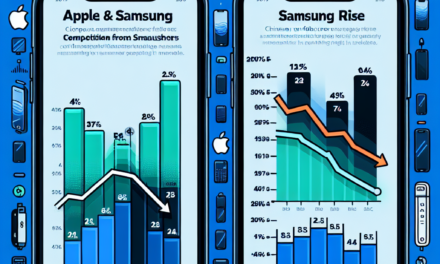“Upstart Stock Soars 51% in 2024: Unveiling the Secrets Behind the Surge!”
Introduction
Upstart Holdings, a leading AI-driven lending platform, has experienced a remarkable surge in its stock price, soaring 51% in 2024. This impressive growth can be attributed to several key factors, including a robust recovery in the lending market, the successful implementation of advanced machine learning algorithms that enhance credit risk assessment, and strategic partnerships that have expanded its market reach. Additionally, positive investor sentiment and strong quarterly earnings reports have further fueled the stock’s upward trajectory, positioning Upstart as a significant player in the fintech industry.
Upstart’s Innovative AI Lending Model
Upstart, a financial technology company that leverages artificial intelligence to enhance the lending process, has recently experienced a remarkable surge in its stock price, soaring by 51% in 2024. This impressive growth can be attributed to several factors, with the company’s innovative AI lending model standing out as a primary driver of its success. By utilizing advanced algorithms and machine learning techniques, Upstart has transformed the traditional lending landscape, enabling more efficient and accurate credit assessments.
At the core of Upstart’s model is its ability to analyze a wide array of data points beyond the conventional credit score. While traditional lenders often rely heavily on FICO scores to determine creditworthiness, Upstart employs a more holistic approach. This includes evaluating factors such as education, employment history, and even the applicant’s financial behavior. By incorporating these additional data points, Upstart can create a more comprehensive profile of potential borrowers, allowing for better risk assessment and more informed lending decisions.
Moreover, the AI-driven model not only enhances the accuracy of credit evaluations but also expands access to credit for underserved populations. Many individuals with limited credit histories or lower credit scores often find it challenging to secure loans through traditional channels. Upstart’s innovative approach addresses this issue by providing opportunities for these individuals to obtain financing based on their overall financial potential rather than solely on their credit scores. This inclusivity not only benefits borrowers but also opens up new markets for lenders, ultimately driving growth for Upstart.
In addition to improving access to credit, Upstart’s AI lending model significantly streamlines the loan application process. Traditional lending practices can be cumbersome and time-consuming, often requiring extensive documentation and lengthy approval times. In contrast, Upstart’s technology enables a more efficient process, allowing borrowers to complete applications quickly and receive decisions in real-time. This efficiency not only enhances the customer experience but also reduces operational costs for lenders, making Upstart an attractive partner in the financial services industry.
Furthermore, the company’s commitment to continuous improvement and innovation has positioned it as a leader in the fintech space. Upstart consistently invests in research and development to refine its algorithms and expand its product offerings. This dedication to innovation ensures that the company remains at the forefront of the industry, adapting to changing market conditions and consumer needs. As a result, Upstart has garnered significant attention from investors, who recognize the potential for sustained growth driven by the company’s cutting-edge technology.
As Upstart continues to gain traction, its innovative AI lending model is likely to play a pivotal role in shaping the future of finance. The company’s ability to provide more accurate credit assessments, increase access to loans, and streamline the application process has not only attracted a growing customer base but has also positioned it favorably within the competitive landscape of financial technology. Consequently, the recent surge in Upstart’s stock price reflects the market’s recognition of these strengths and the potential for continued success.
In conclusion, Upstart’s innovative AI lending model is a key factor behind its impressive stock performance in 2024. By redefining how creditworthiness is assessed and enhancing the overall lending experience, Upstart is not only transforming the financial services industry but also paving the way for a more inclusive and efficient future in lending. As the company continues to innovate and expand its reach, it is poised to maintain its upward trajectory, making it a noteworthy player in the evolving landscape of fintech.
Market Trends Driving Upstart’s Growth
In 2024, Upstart Holdings, a company specializing in artificial intelligence-driven lending solutions, has experienced a remarkable surge in its stock price, soaring by 51%. This impressive growth can be attributed to several market trends that are reshaping the financial landscape and enhancing Upstart’s position within it. As the demand for innovative financial solutions continues to rise, Upstart has effectively capitalized on these trends, positioning itself as a leader in the evolving lending market.
One of the primary factors driving Upstart’s growth is the increasing reliance on technology in the financial services sector. As traditional banks and lending institutions face pressure to modernize their operations, many are turning to fintech companies like Upstart to provide more efficient and customer-friendly solutions. The integration of artificial intelligence into the lending process allows for more accurate risk assessments, enabling lenders to make better-informed decisions. Consequently, Upstart’s platform, which utilizes machine learning algorithms to evaluate creditworthiness, has gained traction among both consumers and financial institutions seeking to streamline their lending processes.
Moreover, the ongoing shift towards digital banking has further fueled Upstart’s expansion. With consumers increasingly favoring online platforms for their financial needs, the demand for seamless and accessible lending solutions has surged. Upstart’s user-friendly interface and quick application process cater to this growing preference, allowing borrowers to secure loans with minimal hassle. As more individuals seek out digital alternatives to traditional banking, Upstart’s innovative approach positions it favorably in a competitive market.
In addition to technological advancements and the rise of digital banking, the current economic climate has also played a significant role in Upstart’s stock performance. As inflationary pressures and rising interest rates continue to impact consumers, many individuals are turning to personal loans to manage their financial obligations. Upstart’s ability to provide quick access to funds has made it an attractive option for those seeking financial relief. This increased demand for personal loans has not only bolstered Upstart’s revenue but has also enhanced its reputation as a reliable lending partner.
Furthermore, the company’s strategic partnerships with various financial institutions have contributed to its growth trajectory. By collaborating with banks and credit unions, Upstart has expanded its reach and diversified its offerings. These partnerships enable Upstart to leverage its technology while providing traditional lenders with the tools necessary to compete in a rapidly changing market. As more institutions recognize the value of Upstart’s platform, the potential for further growth becomes increasingly apparent.
Another noteworthy trend influencing Upstart’s success is the growing emphasis on financial inclusion. As awareness of the importance of equitable access to credit rises, Upstart’s model, which focuses on a broader range of data points beyond traditional credit scores, aligns well with this movement. By offering loans to individuals who may have been overlooked by conventional lenders, Upstart is not only addressing a critical market need but also enhancing its brand image as a socially responsible company.
In conclusion, Upstart’s remarkable stock performance in 2024 can be attributed to a confluence of market trends that favor technological innovation, digital banking, and financial inclusion. By effectively leveraging these trends, Upstart has positioned itself as a key player in the lending industry, demonstrating the potential for sustained growth in an ever-evolving financial landscape. As the company continues to adapt to changing market dynamics, its future prospects appear increasingly promising.
Investor Sentiment and Upstart’s Stock Surge
In the dynamic landscape of the stock market, investor sentiment plays a pivotal role in determining the trajectory of a company’s stock price. Recently, Upstart Holdings, a technology-driven lending platform, experienced a remarkable surge in its stock price, soaring by 51% in 2024. This dramatic increase can be attributed to a confluence of factors that have positively influenced investor perceptions and market dynamics surrounding the company.
To begin with, the broader economic environment has shifted favorably for Upstart. As interest rates have stabilized and inflationary pressures have begun to ease, consumers are increasingly seeking accessible credit options. Upstart’s innovative approach to lending, which leverages artificial intelligence and machine learning to assess creditworthiness, positions it uniquely in a market that is becoming more competitive. Investors have recognized this potential, leading to heightened interest in the stock. The company’s ability to provide loans to individuals who may not have traditional credit histories has resonated with a demographic eager for financial inclusion, further enhancing its appeal.
Moreover, Upstart’s recent financial performance has bolstered investor confidence. The company reported impressive quarterly earnings that exceeded analysts’ expectations, showcasing robust revenue growth and a significant increase in loan origination volumes. This positive financial outlook has not only attracted new investors but has also encouraged existing shareholders to increase their positions. As a result, the stock’s upward momentum has been fueled by a combination of strong fundamentals and optimistic projections for future growth.
In addition to these financial indicators, strategic partnerships and collaborations have played a crucial role in shaping investor sentiment. Upstart has successfully forged alliances with various financial institutions, expanding its reach and enhancing its credibility in the lending space. These partnerships not only provide Upstart with a broader customer base but also validate its business model in the eyes of investors. The market has responded favorably to these developments, as they signal a commitment to growth and innovation, further driving the stock’s ascent.
Furthermore, the increasing focus on technology in the financial services sector has created a favorable backdrop for Upstart. As traditional banks and lenders seek to modernize their operations, companies like Upstart that offer cutting-edge solutions are well-positioned to capture market share. Investors are keenly aware of this trend, and their enthusiasm for technology-driven financial services has contributed to the stock’s impressive performance. The narrative surrounding Upstart as a disruptor in the lending industry has resonated strongly, leading to a surge in demand for its shares.
Lastly, the overall sentiment in the stock market has shifted towards growth-oriented companies, particularly those in the technology sector. As investors seek opportunities that promise substantial returns, Upstart’s innovative business model and strong growth trajectory have made it an attractive option. The combination of favorable economic conditions, solid financial performance, strategic partnerships, and a growing appetite for technology stocks has culminated in a significant surge in Upstart’s stock price.
In conclusion, the 51% increase in Upstart’s stock in 2024 can be attributed to a multifaceted interplay of factors that have positively influenced investor sentiment. As the company continues to navigate the evolving landscape of the lending industry, its ability to leverage technology and maintain strong financial performance will be critical in sustaining this momentum. Investors remain optimistic about Upstart’s future, and as such, the stock’s trajectory will likely continue to reflect the broader trends within the market and the economy.
Competitive Landscape: Upstart vs. Traditional Lenders
In the evolving landscape of financial technology, Upstart has emerged as a formidable player, particularly in the realm of personal lending. The company’s recent stock surge of 51% in 2024 can be attributed to several factors, one of the most significant being its competitive positioning against traditional lenders. As the financial services industry continues to adapt to technological advancements, Upstart’s innovative approach has allowed it to carve out a niche that distinguishes it from conventional banking institutions.
To begin with, Upstart leverages artificial intelligence and machine learning to assess creditworthiness, a method that contrasts sharply with the traditional credit scoring systems employed by banks. Traditional lenders typically rely on FICO scores and other historical data, which can often overlook potential borrowers who may not fit the conventional mold yet possess the ability to repay loans. In contrast, Upstart’s algorithm evaluates a broader range of variables, including education, employment history, and even geographic location, thereby enabling it to identify creditworthy individuals who might otherwise be denied access to credit. This inclusive approach not only broadens Upstart’s customer base but also enhances its risk assessment capabilities, leading to lower default rates and higher profitability.
Moreover, the speed and efficiency of Upstart’s lending process further set it apart from traditional lenders. While conventional banks often require extensive documentation and lengthy approval times, Upstart’s platform allows for a streamlined application process that can yield loan decisions in a matter of minutes. This agility appeals to a tech-savvy demographic that values convenience and speed, particularly younger consumers who are increasingly seeking alternatives to traditional banking. As a result, Upstart has successfully captured a significant share of the personal loan market, positioning itself as a viable alternative to established financial institutions.
In addition to its technological advantages, Upstart has also benefited from a shifting consumer sentiment towards digital banking solutions. The COVID-19 pandemic accelerated the adoption of online financial services, prompting many consumers to seek out more flexible and accessible lending options. As traditional banks grappled with operational challenges and regulatory constraints, Upstart capitalized on this opportunity by offering a user-friendly platform that meets the evolving needs of borrowers. This shift in consumer behavior has not only bolstered Upstart’s growth but has also prompted traditional lenders to reevaluate their strategies in order to remain competitive.
Furthermore, the competitive landscape is also influenced by regulatory changes that favor fintech companies like Upstart. As regulators increasingly recognize the importance of fostering innovation in the financial sector, they have implemented policies that encourage competition and reduce barriers to entry for new players. This regulatory environment has allowed Upstart to thrive, as it can operate with greater flexibility compared to traditional banks, which often face more stringent compliance requirements.
In conclusion, Upstart’s recent stock performance can be attributed to its strategic advantages over traditional lenders, including its innovative use of technology, efficient lending processes, and the favorable regulatory landscape. As the financial services industry continues to evolve, Upstart’s ability to adapt and meet the changing needs of consumers positions it well for sustained growth. The company’s success not only highlights the potential of fintech solutions but also serves as a reminder of the challenges that traditional lenders face in an increasingly digital world. As Upstart continues to redefine the lending experience, it is likely to remain a key player in the competitive landscape of personal finance.
Financial Performance: Key Metrics Behind the Rise
In 2024, Upstart Holdings, a company specializing in artificial intelligence-driven lending solutions, has witnessed a remarkable surge in its stock price, soaring by 51%. This impressive increase can be attributed to several key financial metrics that underscore the company’s robust performance and strategic positioning within the financial technology sector. As investors seek to understand the underlying factors contributing to this growth, it is essential to examine the financial performance indicators that have played a pivotal role in Upstart’s ascent.
One of the most significant metrics reflecting Upstart’s financial health is its revenue growth. In the first quarter of 2024, the company reported a staggering year-over-year revenue increase of 80%, driven primarily by a surge in loan origination volumes. This growth can be attributed to Upstart’s innovative use of machine learning algorithms, which have enabled the company to assess creditworthiness more accurately than traditional methods. By expanding its lending capabilities and reaching a broader customer base, Upstart has positioned itself as a leader in the evolving landscape of personal loans, thereby attracting both borrowers and investors alike.
Moreover, the company’s gross profit margin has also shown substantial improvement, rising to 45% in the latest quarter. This increase is indicative of Upstart’s operational efficiency and its ability to manage costs effectively while scaling its business. The enhanced margin not only reflects the company’s successful pricing strategies but also highlights its commitment to maintaining a sustainable business model. As Upstart continues to refine its technology and streamline its operations, investors are likely to view this metric as a positive sign of long-term profitability.
In addition to revenue and gross profit margins, Upstart’s customer acquisition costs have decreased significantly, further bolstering its financial performance. The company has successfully reduced its marketing expenses while simultaneously increasing its customer base, resulting in a lower cost per acquisition. This efficiency is crucial in a competitive market, as it allows Upstart to allocate resources more effectively and invest in further growth initiatives. As a result, the decline in customer acquisition costs has contributed to an overall improvement in the company’s bottom line, making it an attractive option for investors seeking growth opportunities.
Furthermore, Upstart’s net income has turned positive, marking a significant milestone for the company. In the previous year, Upstart faced challenges that impacted its profitability; however, the recent financial results indicate a turnaround. The positive net income not only enhances investor confidence but also provides the company with the necessary capital to reinvest in its technology and expand its product offerings. This reinvestment strategy is essential for sustaining growth and maintaining a competitive edge in the rapidly evolving fintech landscape.
Lastly, the company’s strong balance sheet, characterized by healthy cash reserves and manageable debt levels, further supports its financial performance. This solid foundation allows Upstart to navigate market fluctuations and invest in strategic opportunities without compromising its financial stability. As the company continues to innovate and adapt to changing market conditions, its financial resilience will likely play a crucial role in sustaining investor interest and driving future growth.
In conclusion, Upstart’s impressive stock performance in 2024 can be attributed to a combination of strong revenue growth, improved profit margins, reduced customer acquisition costs, positive net income, and a robust balance sheet. These key financial metrics not only highlight the company’s operational success but also position it favorably for continued expansion in the competitive fintech sector. As investors closely monitor these developments, Upstart’s trajectory appears promising, suggesting that the company is well-equipped to capitalize on future opportunities.
Future Projections for Upstart’s Stock
As Upstart Holdings, Inc. continues to capture the attention of investors and analysts alike, the future projections for its stock appear increasingly optimistic. Following a remarkable 51% surge in 2024, the company has positioned itself as a significant player in the financial technology sector, particularly in the realm of artificial intelligence-driven lending solutions. This growth can be attributed to several key factors that are likely to influence the stock’s trajectory in the coming months and years.
To begin with, Upstart’s innovative approach to credit scoring and risk assessment has garnered considerable interest. By leveraging advanced machine learning algorithms, the company is able to evaluate potential borrowers more accurately than traditional credit scoring methods. This not only enhances the approval rates for loans but also reduces the risk of defaults, thereby appealing to both lenders and consumers. As more financial institutions recognize the efficacy of Upstart’s technology, partnerships and collaborations are expected to increase, further solidifying the company’s market position.
Moreover, the broader economic landscape plays a crucial role in shaping Upstart’s future. With interest rates fluctuating and inflationary pressures affecting consumer behavior, the demand for alternative lending solutions is likely to rise. Upstart’s ability to provide quick and efficient loan approvals positions it favorably in a market that increasingly values speed and convenience. As economic conditions evolve, the company is well-equipped to adapt its offerings, potentially leading to increased market share and revenue growth.
In addition to these factors, Upstart’s commitment to expanding its product offerings cannot be overlooked. The company has already begun diversifying its services beyond personal loans, venturing into auto loans and other financial products. This strategic expansion not only broadens its customer base but also mitigates risks associated with reliance on a single revenue stream. As Upstart continues to innovate and introduce new financial solutions, it is likely to attract a wider audience, further enhancing its growth prospects.
Furthermore, investor sentiment surrounding Upstart remains robust, bolstered by positive earnings reports and forward-looking guidance. The company’s ability to exceed market expectations has instilled confidence among shareholders, which is crucial for maintaining upward momentum in stock performance. As analysts project continued growth, the potential for upward revisions in earnings estimates could further fuel investor enthusiasm, creating a self-reinforcing cycle of demand for Upstart’s stock.
Additionally, the competitive landscape within the fintech sector is evolving, with traditional banks and new entrants alike seeking to enhance their digital offerings. Upstart’s unique value proposition, characterized by its data-driven approach and customer-centric model, sets it apart from competitors. As the industry continues to embrace technological advancements, Upstart’s first-mover advantage in AI-driven lending could prove to be a significant differentiator, allowing it to capture a larger share of the market.
In conclusion, the future projections for Upstart’s stock are underpinned by a combination of innovative technology, favorable economic conditions, strategic expansion, and strong investor sentiment. As the company continues to navigate the complexities of the financial landscape, its ability to adapt and innovate will be critical in sustaining its growth trajectory. With these factors in mind, investors are likely to keep a close watch on Upstart, anticipating further developments that could influence its stock performance in the years to come.
Risks and Challenges Facing Upstart Moving Forward
As Upstart Holdings, Inc. experiences a remarkable surge in its stock price, soaring 51% in 2024, it is essential to consider the risks and challenges that the company may face moving forward. While the impressive growth can be attributed to various factors, including advancements in artificial intelligence and a robust lending platform, the road ahead is not without obstacles that could impact its trajectory.
One of the primary challenges Upstart faces is the evolving regulatory landscape surrounding the financial technology sector. As governments and regulatory bodies become increasingly vigilant about consumer protection and data privacy, Upstart must navigate a complex web of compliance requirements. Any misstep in adhering to these regulations could result in significant fines or restrictions on its operations, potentially undermining investor confidence and affecting its market position. Furthermore, as Upstart expands its services, it may encounter different regulatory environments in various jurisdictions, complicating its growth strategy.
In addition to regulatory challenges, Upstart must contend with the competitive landscape of the fintech industry. The rapid growth of digital lending has attracted numerous players, from established banks to emerging startups, all vying for market share. This heightened competition could lead to pricing pressures, as companies may be compelled to lower interest rates or offer more favorable terms to attract borrowers. Consequently, Upstart’s profit margins could be adversely affected, which may hinder its ability to reinvest in technology and innovation, essential components for maintaining its competitive edge.
Moreover, the economic environment poses another layer of risk for Upstart. As interest rates fluctuate and inflationary pressures persist, consumer borrowing behavior may shift. A potential economic downturn could lead to increased default rates on loans, impacting Upstart’s credit risk assessment models. Although the company employs advanced algorithms to evaluate borrower creditworthiness, unforeseen economic conditions could challenge these models’ effectiveness. If borrowers begin to default at higher rates, Upstart’s financial performance could suffer, leading to a decline in investor sentiment.
Additionally, the reliance on technology presents inherent risks. Upstart’s business model is heavily dependent on its proprietary artificial intelligence algorithms, which analyze vast amounts of data to make lending decisions. While this technology has proven effective, any technical failures or data breaches could severely damage the company’s reputation and operational capabilities. Furthermore, as the technology landscape evolves, Upstart must continuously innovate to stay ahead of potential disruptions. Failing to adapt to new technological advancements or shifts in consumer preferences could render its offerings less appealing in a rapidly changing market.
Lastly, investor sentiment plays a crucial role in Upstart’s future performance. The stock market is often influenced by broader economic trends and investor perceptions, which can be volatile and unpredictable. If market conditions shift or if investors lose confidence in Upstart’s growth prospects, the stock could experience significant fluctuations. Maintaining transparency and effectively communicating its strategic vision will be vital for Upstart to sustain investor trust and support.
In conclusion, while Upstart’s recent stock surge is a testament to its innovative approach and market potential, the company must remain vigilant in addressing the myriad risks and challenges that lie ahead. By proactively navigating regulatory hurdles, adapting to competitive pressures, managing economic uncertainties, safeguarding its technological infrastructure, and fostering investor confidence, Upstart can position itself for sustained growth in the dynamic fintech landscape.
Q&A
1. **What is Upstart’s primary business model?**
Upstart uses artificial intelligence to provide personal loans and improve credit scoring.
2. **What factors contributed to Upstart’s 51% stock increase in 2024?**
Key factors include improved financial performance, increased loan origination volume, and positive market sentiment towards AI-driven financial services.
3. **How did Upstart’s earnings report impact its stock price?**
The earnings report exceeded analyst expectations, showcasing strong revenue growth and profitability, which boosted investor confidence.
4. **What role did macroeconomic conditions play in Upstart’s stock performance?**
Favorable macroeconomic conditions, such as lower interest rates and a recovering job market, enhanced consumer borrowing and spending.
5. **How has Upstart’s technology differentiated it from competitors?**
Upstart’s AI algorithms allow for more accurate risk assessment, enabling it to approve loans for borrowers who may be overlooked by traditional lenders.
6. **What are analysts predicting for Upstart’s future growth?**
Analysts are optimistic about Upstart’s growth potential, citing expanding market opportunities and ongoing advancements in its technology.
7. **What risks should investors consider regarding Upstart’s stock?**
Investors should be aware of risks such as regulatory changes, competition in the fintech space, and potential economic downturns affecting loan performance.
Conclusion
Upstart’s stock surge of 51% in 2024 can be attributed to several key factors, including improved financial performance, strategic partnerships, advancements in AI technology, and a favorable market environment for fintech companies. The company’s ability to enhance its lending algorithms and expand its customer base has also played a significant role in boosting investor confidence and driving stock prices higher. Overall, Upstart’s strong growth trajectory and innovative approach position it well for continued success in the evolving financial landscape.





